INTRODUCTION
To follow is Chapter 7 in a series that is my personal tranformative journey from my early years. This story began with me living as a long term unemployed single parent with two children with different fathers, never being married. I was definitely on the bottom rung of society. I lived in the highest unemployed town in the UK with the demise of its Iron and Steel, Chemical and Shipbuilding industries, thus experiencing years of poverty and ostracisation. This is the story of how, supported by a strong Christian faith, I deeply analysed and navigated my way through it all, to an absolutely fulfilling life.
In the light of what’s happening in this chaotic world today, I feel moved to tell my story with all its different facets, because my main hope is that the reader will see the human face of the marginalised. Then, hopefully, gain a more compassionate understanding of all those who live on the margins of society. I hope the reader finds clues on how to make connections with people different from them, or to change the top down competitive economic system so all people are justly valued whether they were in paid work or out of paid work.
I invite the reader to pick any chapter and, if it resonates with you, to organise a zoom working group in the New Republic of the Heart community to discuss and explore any particular issue or let it inform the work you are already doing.
I acknowledge that every single one of us has our own unique experience from our own unique perspective waiting to be heard and learned from. This is simply my experience. I’d love to maybe one day hear and learn from yours.
Linda Granville
To read Chapter 6, click HERE.
◊◊◊◊◊◊◊◊◊◊◊◊◊◊◊◊◊◊◊◊◊◊◊◊◊◊◊◊◊◊◊◊
CHAPTER 7 ~ FROM SPIRITUAL RETREATS TO ACTION
“What could be more insane than to oppose life itself, which is now and always now? Surrender to what is. Say “yes” to life — and see how life suddenly starts working for you rather than against you.”
~ Eckhart Tolle
To refresh my own spirituality, I went alone on a week-long singles retreat in the United Reformed Church bothy on the Holy Island of Lindisfarne. Being only 150 miles from my home in Middlesbrough, this was always my ‘go to’ when life was crowding around me and I needed clarity, especially when faced with the occasional big life question.
For a little history, Lindisfarne has been a place of Christian pilgrimage since the 6th century when St. Aiden brought Christianity to the north east of England from Iona off the western coast of Scotland. He was renowned for bringing Celtic Christianity not only to the poorest of the poor, but also to Oswald, the Northumbrian King. Oswald lived four miles across the bay in Bamburgh Castle and, inspired by St. Aiden, converted to Christianity along with all his northern kingdom.
The Holy Island of Lindisfarne is a tidal island and is located along the north east coast of England, close to the border of Scotland. It measures 3.0 miles (4.8 km) from east to west and 1.5 miles (2.4 km) from north to south. It comprises approximately 1,000 acres (400 hectares) at high tide, and its nearest point is about 0.8 miles (1.3 kilometres) from the mainland. It is accessible at low tide by a modern causeway, and an ancient pilgrim’s path that runs over sand and mudflats that are covered with water at high tide.
Lindisfarne is surrounded by the 8,750-acre (3,540-hectare) Lindisfarne National Nature Reserve, which protects the island’s sand dunes and the adjacent intertidal habitats. In 2008 it had a population of about 180. St. Cuthbert’s Island, named for St. Cuthbert, is a very short walking distance from Lindisfarne village when the tide is out. The feeling of walking on this land in the footsteps of saints is palpable. Sitting beneath its cross to meditate must have inspired and replenished the many thousands of pilgrims these last one thousand five hundred years.
St. Cuthbert lived between 634 and 687 AD. He was known for his good works and miracles, and eventually became bishop of Lindisfarne. When the monks who lived on Lindisfarne fled Viking attacks in the 9th Century, they carried St Cuthbert with them in his coffin, eventually settling at Durham Cathedral.
The spiritual director there was a gentleman by the name of Ian. He was the caretaker of Marygate House, a retreat house on the Island. He had heard about the interfaith work I was doing, and was excited because, for the first time in their history, the Churches Together organization on Lindisfarne wanted to officially make multifaith links. This inspired those at the Marygate House to offer our Faiths in Action women’s group a FREE five-day retreat for up to 15 multifaith /multicultural women from Nottingham, and did so for two more years afterward.
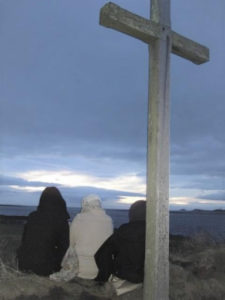 These retreats were a great blessing. Over the three retreats, some of the same and some different women attended. Our group of Muslim Sikh, Jewish, fundamental and liberal Christian women found ourselves cut off from the mainland, away from the noise left behind in Hyson Green that was three hundred miles away.
These retreats were a great blessing. Over the three retreats, some of the same and some different women attended. Our group of Muslim Sikh, Jewish, fundamental and liberal Christian women found ourselves cut off from the mainland, away from the noise left behind in Hyson Green that was three hundred miles away.
In our time together, we broke down misconceptions about each other’s faith. We were shown a video on the life of Mohammed. We listened to each other’s personal and faith journeys at a deep level, and made lasting genuine friendships. Through our personal stories we found that the one thing that connected us all was our shared experience of being a woman, and within that, our experience of domestic violence.
After returning from the first February retreat in 2008, some of the women joined the Nottingham Area 4 Domestic Violence Forum to organise a women’s conference on Domestic Violence in Faith Communities. I continued my research of the different faiths to try to find clues on why women across the world were subordinate to men. I didn’t have to go further than my own Christian faith. I researched an article called ‘Women in the Lectionary’ written by a Catholic female theologian called Ruth Fox. The Lectionary comprises passages from the bible, one from the old testament and at least one from the new testament. All the major church denominations worldwide use the same readings every week. Over a rotating period of three years, it’s understood that the whole bible is read.
Ruth Fox quotes…
The widely-held assumption has been that the lectionary faithfully presents the essence of the Bible, with the omission of a few troubling or gory passages. A careful analysis of the lectionary reveals that a disproportionate number of passages about the women of the Bible have been omitted. Women’s books, women’s experiences and women’s accomplishments have been largely overlooked in the assigned scripture readings that are being proclaimed in our churches on Sundays and weekdays. In this article I will point out some of the significant biblical passages about women that are omitted altogether, are relegated to weekdays, where only a small number of churchgoers will hear them or are designated as optional. I hope to illustrate how some of the lectionary’s readings are used to reinforce what some believe to be the weaknesses or proper roles of women.
It was men that devised the Lectionary. To read the full report, please Google: ‘Women in the Lectionary.’
Not long after our first retreat, Ian rang me to generously invite multifaith women to go to Lindisfarne again, a year later in February 2009.
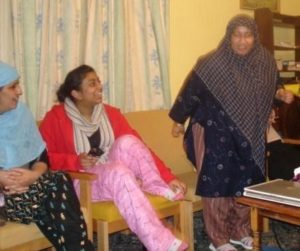 Sheba (in the centre of the picture) was a Christian whose family had lived in Libya, but originated from Pakistan. Her parents and teenage brother and sister were living with me in Nottingham for a short time while seeking Asylum in England. I had invited her to join our multifaith group at the Lindisfarne retreat. At the time a number of churches I worked with, especially the church that Sheba attended, were ardently praying for the safety of the minority Christian population in Pakistan who were living in great fear of being killed or their houses burned down by the Pakistan Muslim majority, and a lot of them were fleeing their homes. This Pakistan Christian / Pakistan Muslim encounter added a new dynamic to our group, with friendships and an understanding of “the other” being made between faiths.
Sheba (in the centre of the picture) was a Christian whose family had lived in Libya, but originated from Pakistan. Her parents and teenage brother and sister were living with me in Nottingham for a short time while seeking Asylum in England. I had invited her to join our multifaith group at the Lindisfarne retreat. At the time a number of churches I worked with, especially the church that Sheba attended, were ardently praying for the safety of the minority Christian population in Pakistan who were living in great fear of being killed or their houses burned down by the Pakistan Muslim majority, and a lot of them were fleeing their homes. This Pakistan Christian / Pakistan Muslim encounter added a new dynamic to our group, with friendships and an understanding of “the other” being made between faiths.
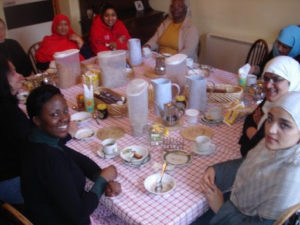 One late afternoon at low tide I walked alone across to St. Cuthbert’s Island to also pray for the whole situation. I sat in the open hollow near it’s cross. I became so engrossed in prayer that when I came out of it, I was surrounded by the incoming tide, and had to be rescued by a local lifeboat. Over the years I’d always wanted to spend a full tide on St Cuthbert’s Island, however to spend a full tide overnight on a freezing cold February night with only the barking of the occasional seal and squalls of sea birds to keep me company, was not a healthy option.
One late afternoon at low tide I walked alone across to St. Cuthbert’s Island to also pray for the whole situation. I sat in the open hollow near it’s cross. I became so engrossed in prayer that when I came out of it, I was surrounded by the incoming tide, and had to be rescued by a local lifeboat. Over the years I’d always wanted to spend a full tide on St Cuthbert’s Island, however to spend a full tide overnight on a freezing cold February night with only the barking of the occasional seal and squalls of sea birds to keep me company, was not a healthy option.
Immediately after this retreat we came home to the news that Gaza had been bombed. The killing of so many innocent children was shown on television screens across the world. Our large Muslim community was in uproar. I was shown scenes on their Al Jazeera TV network where the BBC network apparently found the scenes too horrendous to publish. One unforgettable scene was of a dead baby, cindered black from top to bottom, being held in the arms of its father. One member of our group, Zarifa, was a Palestinian Muslim whose family was living in Gaza.
The day after arriving home from Holy Island I was strongly encouraged to go to a Stop the War Coalition meeting with her and other women from our group, I hadn’t heard of Stop the War Coalition before. The community came together to see how they could find ways to tell our UK government to help stop the bombing. The organisers offered a few suggestions: a march in Nottingham, and also a march in London with others from across the country. I became quite worried when one suggestion was to have a silent gathering outside the Jewish Holocaust Museum near Nottingham. I, along with a few others in the room, felt extremely uncomfortable about this option. We were told that it would be a peaceful gathering in silence, but I felt nobody could guarantee that since there was always the danger of a tiny minority factor that could disrupt everything.
Another suggestion was to arrange a silent candlelight vigil outside Nottingham City Council House to light candles for innocent victims of both sides of the conflict. I immediately volunteered to help coordinate that group. I had the job of buying a giant candle and a few hundred smaller candles, and others arranged speakers from the Muslim and Jewish community. However there were still people who wanted to gather outside the Holocaust Museum. The decision on whether or not to do this was postponed until the next Stop the War meeting to take place the following week.
I was extremely worried. I didn’t want it to appear that we were against the Jewish people, but only protesting against the Israeli government’s disproportionate bombing of the Palestinians. Gathering outside the Holocaust Museum could be misinterpreted, and also would not respect all the Jews who had died in the Holocaust. I was afraid this could escalate into something explosive.
Meanwhile I had been nominated by the United Reformed Church to represent them on “Nottingham Interfaith Council.’ I was on my way to my first meeting with them the day after the Stop the War meeting. I already knew some of the people on the council. We made connections with our local Faiths in Action group, and planned a joint gathering on the Holocaust Memorial Day that they organised every year. Since it was on their agenda to plan this year’s Holocaust Memorial Day, I wanted to warn them to go the meeting the following week and vote against campaigning outside the Holocaust Museum. I saw some local Muslims on the committee and I didn’t know if any of them were involved or not in organising the march. I realised, because I was late finding the meeting, that I must have missed the Holocaust Memorial Day discussion as it wasn’t talked about. At the end I found John, the chair of the Interfaith Council going out the door he grabbed me by the arm and in a panic said, ”Do you realise there’s going to be a demonstration outside the Holocaust Museum!” I said, “No John…they haven’t decided yet. They’re going to decide next Wednesday at their next meeting. They’re going to have a vote. People need to get there to vote if they don’t want this to happen.” I had phone calls between John and myself throughout the week. I was so stressed about all of this that my doctor sent me to see a counsellor.
The Interfaith Council worked within the County of Nottinghamshire as well as Nottingham City. Its Committee seemed to be professional people from all faiths. However it seemed to me some were out of touch with the real issues affecting the local communities. John knew of the work I was doing in Hyson Green and asked my advice on what the feelings were among the grassroots of the community. I told him that they were disappointed that the Interfaith Council had not yet put out a public statement concerning the bombing. A statement was then put out but a number in the community were a bit dissatisfied with the narrowness of it. I urged John to get people to go to the meeting. At this point I was so stressed I wanted to give everything up and stay away. However I knew how important it was. On the day of the meeting to vote, out of all the many people at the previous meeting only eleven people turned up to represent the rest of the group.
I couldn’t see anybody at all from the Interfaith Council. However I sat next to a Union Rep and she told me that John had asked her to come. It was announced that whatever the vote was, all the Stop the War members would all have to abide by it. I immediately spoke up and said “I’m sorry, but whatever the decision, I personally will not demonstrate outside the Holocaust Museum.” At once a Muslim girl said, “Neither will I.” She continued to say, ”When I left the meeting last week I was caught up in all the rhetoric and agreed to the demonstration without really thinking of the consequences. But when I got home and told my father he was absolutely angry and shouted at me saying, “You fool! People might think we’re against the Jews and we’re not! We’re against the Israeli government and how they’ve used their imbalanced military super power against the bombing of innocent civilians.” This very same conversation went around others in the circle. Other Muslims had a very similar story concerning their family and did not want to be seen to be against the Jewish people.
The very close final result was six to five NOT to do the demonstration. I breathed a deep sigh of relief. I completely understood the anger of those who lost the vote. I know they had in mind the shrinking map of Palestine since 1967 and the ongoing grossly unjust humiliation of the Palestinian people.
‘The conflict resulted in between 1,166 and 1,417 Palestinian and 13 Israeli deaths including 4 from friendly fire.’ ‘Gaza War (2008–2009)’ Wikipedia
With the Stop the War Coalition, Zarifa and I marched in Nottingham and London together against the bombing. 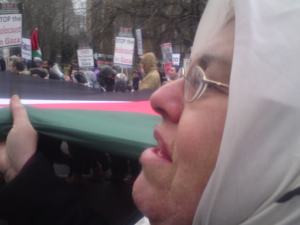
Zarifa holding the Palestinian Flag
Our silent candlelight vigil outside Nottingham City Council House for innocent victims from both sides of the conflict went ahead. We listened to Jewish, Muslim and Christian speakers. Even the Jewish speakers were against the bombing.
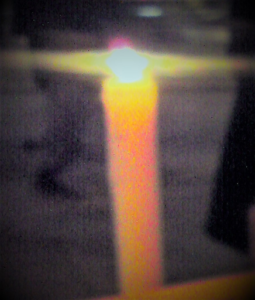 A tiny light of hope shone when a Palestinian Muslim, Mousa, who was studying at Nottingham University came into the church community cafe where I worked. He told me of his three-year-old niece, Marah, who lived on the West Bank in Palestine and was seriously ill with leukaemia. He told me how a Jewish doctor was treating her without payment and how immensely grateful he was to her. He was also grateful for his Jewish friends who were helping Marah by taking her quickly to the hospital on the Israeli side of ‘The Wall,’ bypassing the checkpoint where many Palestinian people often waited in line for many hours.
A tiny light of hope shone when a Palestinian Muslim, Mousa, who was studying at Nottingham University came into the church community cafe where I worked. He told me of his three-year-old niece, Marah, who lived on the West Bank in Palestine and was seriously ill with leukaemia. He told me how a Jewish doctor was treating her without payment and how immensely grateful he was to her. He was also grateful for his Jewish friends who were helping Marah by taking her quickly to the hospital on the Israeli side of ‘The Wall,’ bypassing the checkpoint where many Palestinian people often waited in line for many hours.
This was a brilliant story to spread around the angry local community in Nottingham to show that not all Jewish people were against the Palestinians. However, a few weeks later Mousa returned looking very despondent telling me that the Jewish doctor was now unable to treat his niece for nothing. Marah’s family couldn’t possibly afford to pay fees. Her condition suddenly became critical as the Palestinian hospital, with far less resources, had no facilities to treat leukaemia.
I immediately set up a fundraising campaign to help Marah. I contacted all my contacts in the community including Nottingham Interfaith Council and Mousa contacted his friends at Nottingham University. Together we reached our goal to get Marah her much deserved treatment. She eventually became completely cured.
One Jewish donor from the Interfaith Council had, in the past, worked in the Israeli hospital where Marah was treated. He included a letter with his donation that reached Marah’s parents wishing her well. I heard later that Marah’s family living in the West Bank framed his letter and hung it on their wall to show their Palestinian neighbours how a Jewish person helped Marah, even when the bombing was still taking place, killing their fellow Palestinians in Gaza.
This was telling me that, in the midst of what I have come to believe about the terrible Israeli policies against the Palestinians, and the terrible Gaza government policies toward the Israelis in retaliation (Gaza has an independent governing body from the West Bank), that ordinary Palestinians and Jews were stretching out a hand of friendship to each other. This still gives me a little candlelight flicker of hope for that troubled area. It shows me how ordinary people on both sides are crying out for peace, albeit peace with justice. This is the biggest issue to overcome, especially in the eyes of the Palestinian people and those Israelis who had suffered. One question still remained for me: Why were the Palestinians so poor that they didn’t have the resources in their own hospitals to provide the treatment that Marah, this innocent three-year-old, so desperately needed?
Note: About eight years after my retirement, I was invited to Ramallah on the West Bank by Mousa to finally meet Marah who was by then a beautiful eleven year old. It was on that trip that I for the first time saw for myself the unjust, still ongoing oppressive conditions the Palestinian people were living under (which I again reference in my last chapter).
I soon realised there was not one Jewish person on our local women’s Faith’s in Action Group. I thought if there was, maybe local relationships could be healed between local Jews and Muslims. The area boundaries of my local work place mostly consisted of fundamental and Liberal Christians of all denominations and cultures, and nearly as many Muslims. There were Sikh and Hindu as well, and many African house churches which were mostly fundamental with a church from Ethiopia. But I didn’t know of any local Jews in the area.
I was sad, because very understandably, especially at this point, Zarifa had an aversion to Jews. I spoke to her beforehand, to test her feelings before I asked our group if we could invite a Jewish woman, Cindy, on board even if she didn’t live locally. I met Cindy at the Interfaith Council and though she lived on the other side of Nottingham, I invited her and she was welcomed by all the women, including tentatively by Zarifa. Zarifa was a little bit hesitant at first, and I couldn’t blame her under her circumstances of intensely worrying about her family in Gaza. She eventually relaxed during a multifaith cookery project we set up which included Cindy and Zarifa. Zarifa loved cooking and was a brilliant cook. Cindy introduced the group to more Jewish women out of our local area. After my retirement Cindy played a major part in keeping our group together.
We fully expected that the 2009 retreat would be our last. In 2010 I kept in close contact with Ian for spiritual support when things in Nottingham got quite stressful. On hearing of my impending retirement in 2011 he again offered us a final 2011 February retreat, as he said, to celebrate my retirement. 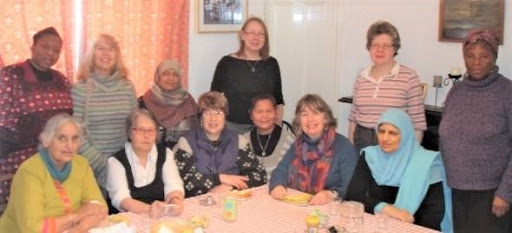
This 2011 February retreat was used to plan a Celebration Women’s Event in Nottingham on International Women’s Day the following month. I gave a talk about the Faiths in Action Women’s group, the work we had done together, and the friendships we had built. Local women alongside their children read poetry, danced and sang songs. Some spoke about their different faiths. We held children’s games and crafts. I led some simple community singing with actions to enable most people to join in.
These Holy Island retreats were a great blessing for many. Once a day the high tide cut us off from the mainland, as though we were being cut off from negative life situations back in Nottingham and the thinking mind, we became present to the NOW.
While on silent walks around the island we took in the beauty of the wild flowers creeping through the cracks of ancient stone walls. We listened to the crashing waves, sounds of migrating seabirds and took in the deep palpable atmosphere of the historic holy history of the Island, stepping in the footsteps of the early Christian Saints.
These experiences empowered us all in some mysterious way to go back to our hustle and bustle of life in Nottingham with more clarity and a determination to change our little corner of the world for the better.
To read Chapter 6, click HERE.

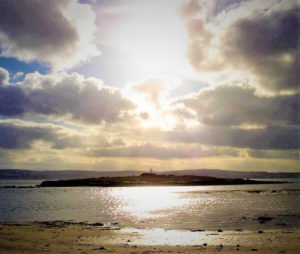
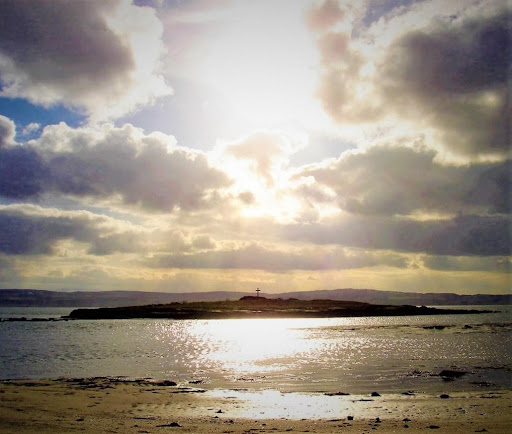
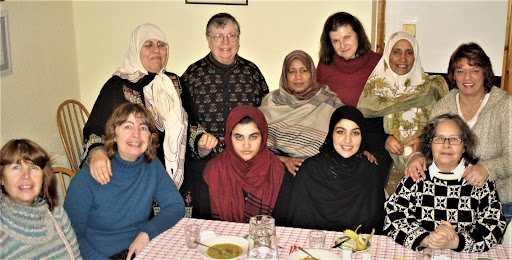
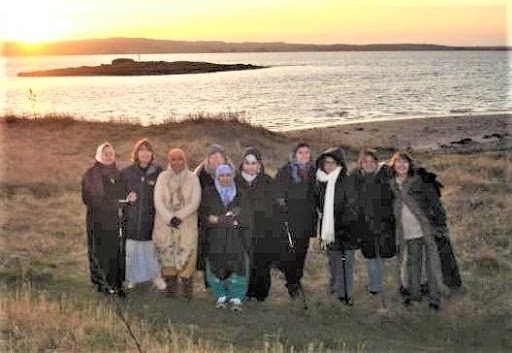
0 Comments